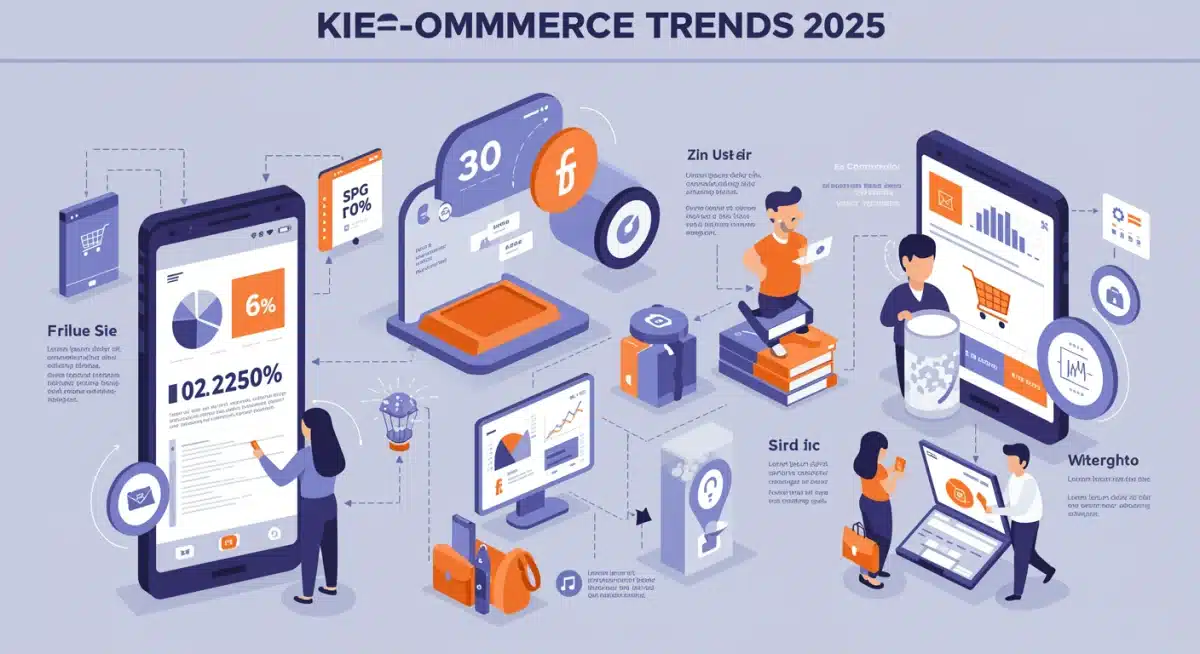Analyzing the 2025 Outlook for U.S. E-commerce Growth: Strategies for Online Retailers

The 2025 outlook for U.S. e-commerce growth indicates continued expansion driven by evolving consumer expectations and technological advancements, necessitating agile strategies for online retailers to maintain competitiveness and profitability.
As of late 2024, the digital retail landscape is buzzing with anticipation regarding the trajectory of online sales. Analyzing the 2025 Outlook for U.S. E-commerce Growth: Strategies for Online Retailers reveals a pivotal year ahead, marked by both significant opportunities and formidable challenges. Understanding these dynamics is crucial for businesses aiming to not just survive but thrive in an increasingly competitive market.
Projected Growth Trajectories and Market Dynamics
The U.S. e-commerce market is poised for robust expansion in 2025, building on the accelerated digital adoption seen in recent years. Analysts project continued double-digit growth, albeit with a normalization from pandemic-era surges. This sustained upward trend is fueled by persistent consumer preference for online shopping convenience, coupled with ongoing technological advancements that enhance the digital experience.
Several key factors are shaping these growth trajectories. The increasing penetration of high-speed internet, particularly in underserved areas, broadens the consumer base. Furthermore, the demographic shift towards younger, digitally native generations reaching prime spending age significantly contributes to the overall market expansion. Retailers must recognize these underlying currents to position themselves effectively for the coming year.
Key Drivers of E-commerce Expansion
Understanding what propels this growth is vital for strategic planning. It’s not just about more people shopping online; it’s about how and why they choose to do so.
- Mobile Commerce Dominance: Smartphones are becoming the primary shopping device for a growing segment of consumers, demanding optimized mobile experiences.
- Personalization and AI: Advanced algorithms and AI-driven recommendations are enhancing customer engagement and conversion rates by tailoring shopping journeys.
- Seamless Omnichannel Integration: Consumers expect a consistent and fluid experience across all touchpoints, from online to in-store and back again.
- Sustainability and Ethical Sourcing: A rising number of consumers are making purchasing decisions based on a brand’s environmental and social impact.
Navigating Evolving Consumer Behaviors
Consumer expectations are not static; they are continuously evolving, driven by technological innovation and societal shifts. For online retailers, keeping pace with these changes is paramount. In 2025, shoppers will demand more than just competitive pricing; they will seek authentic brand experiences, unparalleled convenience, and a clear alignment with their values.
The rise of Gen Z as a significant spending force means a greater emphasis on social commerce, influencer marketing, and brands that demonstrate transparency and purpose. Retailers must adapt their marketing strategies to resonate with this demographic, moving beyond traditional advertising to more interactive and community-driven approaches. The pandemic also solidified the importance of contactless options and flexible delivery, which remain high priorities for many consumers.
The Impact of Digital Natives on Purchasing Habits
Younger generations are inherently digital, shaping the future of retail. Their preferences dictate new norms for online engagement.
- Social Commerce Integration: Shopping directly through social media platforms is gaining traction, requiring brands to invest in platform-specific strategies.
- Experiential Shopping: Augmented reality (AR) and virtual reality (VR) are beginning to offer immersive product experiences, allowing consumers to ‘try before they buy’ virtually.
- Subscription Models: The convenience of recurring deliveries for everyday items or curated boxes continues to attract consumers seeking simplicity and value.
- Value-Driven Purchases: Consumers, especially younger ones, prioritize brands that demonstrate ethical practices, sustainability, and social responsibility.
Technological Innovations Shaping the Retail Landscape
Technological innovation remains the bedrock of e-commerce evolution. In 2025, online retailers will leverage advanced tools to optimize operations, enhance customer experiences, and unlock new revenue streams. From artificial intelligence to blockchain, these technologies are not just buzzwords; they are becoming essential components of a competitive digital strategy.
AI, in particular, is moving beyond basic chatbots to power sophisticated predictive analytics, personalized product recommendations, and optimized inventory management. Machine learning algorithms are enabling dynamic pricing strategies and more efficient supply chain logistics. Retailers who embrace these innovations stand to gain significant advantages in efficiency and customer satisfaction.
Frontier Technologies for E-commerce
The next wave of innovation promises to redefine how online businesses operate and interact with customers.
- Artificial Intelligence and Machine Learning: Enhancing everything from customer service to fraud detection and supply chain optimization.
- Blockchain for Supply Chain Transparency: Providing immutable records for product origins, ethical sourcing, and counterfeit prevention, building consumer trust.
- Augmented and Virtual Reality: Revolutionizing product visualization and virtual try-on experiences, reducing returns and increasing engagement.
- Voice Commerce and Conversational AI: Enabling hands-free shopping through smart speakers and intelligent assistants, opening new channels for sales.

Optimizing Logistics and Supply Chain Resilience
The lessons learned from recent global disruptions underscore the critical importance of resilient and efficient supply chains. In 2025, online retailers must prioritize strategic investments in logistics to meet consumer demands for fast, reliable, and often free shipping. This involves a multi-faceted approach, from diversifying supplier networks to adopting advanced warehouse automation.
Last-mile delivery remains a significant challenge and opportunity. Retailers are exploring innovative solutions like drone delivery, autonomous vehicles, and expanded local fulfillment centers to reduce delivery times and costs. Furthermore, the emphasis on sustainability extends to logistics, with a growing push for eco-friendly packaging and reduced carbon footprints in transportation.
Strategies for Enhanced Supply Chain Performance
A robust supply chain is no longer a competitive advantage, but a necessity for e-commerce success.
- Diversified Supplier Networks: Reducing reliance on single sources to mitigate risks from geopolitical events or natural disasters.
- Micro-Fulfillment Centers: Strategically located smaller warehouses closer to urban areas to enable faster delivery times.
- Automation in Warehousing: Utilizing robotics and AI to improve picking, packing, and sorting efficiency, reducing labor costs and errors.
- Sustainable Logistics: Implementing electric delivery vehicles, optimizing routes, and using recyclable packaging to meet environmental goals.
Data Security and Privacy Concerns
As e-commerce transactions become more sophisticated, so do the threats to data security and consumer privacy. In 2025, online retailers must double down on their efforts to protect sensitive customer information, not only to comply with evolving regulations but also to maintain consumer trust. Data breaches can have devastating consequences, both financially and reputationally.
New privacy regulations, both domestically and internationally, will continue to shape how data is collected, stored, and used. Retailers must invest in robust cybersecurity measures, implement transparent data policies, and educate their customers on how their information is being protected. Trust is a cornerstone of online commerce, and safeguarding data is fundamental to building and maintaining it.
Building Trust in a Digital Age
Proactive measures in data security and privacy are essential for long-term customer relationships.
- Advanced Encryption: Implementing state-of-the-art encryption protocols for all data in transit and at rest.
- Multi-Factor Authentication (MFA): Offering and encouraging MFA for customer accounts to enhance security against unauthorized access.
- GDPR and CCPA Compliance: Ensuring full adherence to global and regional data protection regulations, demonstrating commitment to privacy.
- Regular Security Audits: Conducting frequent vulnerability assessments and penetration testing to identify and address potential weaknesses.
Embracing Sustainability and Ethical Practices
Beyond profit margins, consumers are increasingly scrutinizing the ethical and environmental footprint of the brands they support. In 2025, integrating sustainability and ethical practices will not just be a ‘nice-to-have’ but a commercial imperative for online retailers. This encompasses everything from sourcing materials responsibly to minimizing waste in packaging and operations.
Brands that authentically communicate their commitment to sustainability and social responsibility will build stronger connections with conscious consumers. This involves transparent reporting on environmental impact, fair labor practices, and community engagement. Retailers should view sustainability as an opportunity for innovation and differentiation, rather than merely a compliance burden.
Sustainable Business Models for Online Retailers
Integrating sustainability into core business practices creates value for both the planet and the bottom line.
- Circular Economy Initiatives: Implementing take-back programs, repair services, or resale platforms to extend product lifecycles.
- Eco-Friendly Packaging: Shifting away from single-use plastics to biodegradable, recyclable, or compostable packaging materials.
- Ethical Sourcing and Fair Trade: Ensuring that products are manufactured under fair labor conditions and sourced responsibly, with transparent supply chains.
- Carbon Neutral Operations: Investing in renewable energy, optimizing logistics to reduce emissions, and offsetting unavoidable carbon footprints.
Competitive Strategies for Online Retailers in 2025
The competitive landscape in U.S. e-commerce is intensifying. Standing out will require more than just a great product; it will demand a holistic strategy that encompasses brand building, customer experience, and operational excellence. Retailers must continuously innovate and adapt to stay ahead of the curve, leveraging data to inform their decisions and personalize their offerings.
Differentiation can come from niche market specialization, unparalleled customer service, or a unique brand story. Investing in strong digital marketing, including SEO, content marketing, and targeted advertising, will be crucial for visibility. Ultimately, success in 2025 will hinge on a retailer’s ability to create a compelling value proposition that resonates with their target audience and fosters long-term loyalty.
Key Strategic Imperatives for Success
To thrive in 2025, online retailers must focus on several critical strategic areas.
- Customer-Centricity: Placing the customer at the heart of all decisions, from product development to post-purchase support.
- Agile Business Models: The ability to quickly adapt to market changes, technological shifts, and evolving consumer preferences.
- Data-Driven Decision Making: Utilizing analytics to understand customer behavior, optimize marketing campaigns, and improve operational efficiency.
- Brand Storytelling and Community Building: Creating an emotional connection with consumers through authentic narratives and fostering a sense of belonging.
| Key Aspect | Brief Description |
|---|---|
| Growth Trajectories | Continued robust double-digit growth in U.S. e-commerce, driven by mobile and digital-native demographics. |
| Consumer Behavior | Evolving demands for personalization, ethical practices, and seamless omnichannel experiences. |
| Technological Adoption | Increased integration of AI, AR/VR, and blockchain for efficiency and enhanced customer interaction. |
| Supply Chain Resilience | Focus on diversified networks, micro-fulfillment, and sustainable logistics to ensure timely delivery. |
Frequently Asked Questions About 2025 E-commerce Growth
The main drivers include the continued shift to mobile commerce, sophisticated AI-driven personalization, the expectation of seamless omnichannel experiences, and increasing consumer demand for sustainable and ethically sourced products from online retailers.
AI will significantly enhance online retail by powering predictive analytics for inventory, offering hyper-personalized product recommendations, optimizing customer service through advanced chatbots, and improving fraud detection, leading to greater efficiency and customer satisfaction.
Sustainability is becoming a critical factor; consumers increasingly prefer brands that demonstrate ethical practices, responsible sourcing, and eco-friendly operations. Retailers integrating these values authentically will build stronger trust and loyalty.
Ensuring supply chain resilience involves diversifying supplier networks, investing in micro-fulfillment centers for faster delivery, leveraging automation in warehouses, and adopting sustainable logistics practices to mitigate disruptions and meet consumer expectations.
Key challenges include intense competition, evolving privacy regulations, rising customer acquisition costs, the need for robust cybersecurity, and the imperative to adapt quickly to new technologies and constantly changing consumer expectations regarding experience and values.
Looking Ahead
The 2025 outlook for U.S. e-commerce growth signals a period of dynamic evolution rather than simple expansion. Online retailers must remain agile, proactively embracing technological advancements, prioritizing customer trust through robust data security, and integrating sustainability into their core business models. The ability to adapt to fluid consumer behaviors and leverage data-driven insights will be paramount, shaping the leaders of tomorrow’s digital marketplace. Expect continued innovation in delivery, personalized experiences, and a heightened focus on brand purpose as the sector matures.





